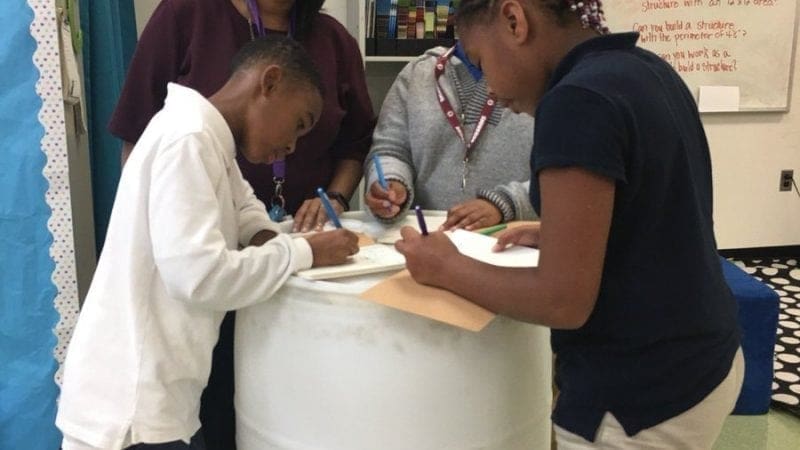When educators use objects or images as a Question Focus it can send elementary school students’ minds racing in new directions.
By Chris Orchard
If a picture is worth a thousand words, how many questions is it worth?
A lot, it seems. We’ve found that elementary school teachers often achieve great results with the Question Formulation Technique when they use a simple image or object as the Question Focus. This provides space for students to carefully read and analyze a visual cue and pursue understanding through question formulation.
For instance, the fourth-graders in Ms. G’s class made some of us feel ancient and outdated by contemplating photographs of old and new technology.
Asking some really thoughtful questions during social studies today! #QFT @KatieMuhtaris @Lines_Principal #Innovations #ssgs pic.twitter.com/V2BDtZtJ7E
— Mrs. W's 3rd Graders (@Lines3MW) November 15, 2017
“What does IBM stand for?” one student asked. “Why do they look different?”
They were grappling with the image of an old desktop computer alongside a modern laptop.
Or consider what what a handful of fourth-graders at Sheafe Road Elementary School in New York wanted to know about the packing peanuts.
“Are they edible?”
“Can you eat packing peanuts?”
They were looking at everyday objects: packing peanuts made from cornstarch next to a Styrofoam* plate and coffee cup.
QFT in action, 4th grade science at Sheafe Road! Students owning their learning through question develop & inquiry! pic.twitter.com/9cD4NSRX6N
— Jim Daley (@GayheadWCSD) November 9, 2017
Based on a Twitter post by Sheafe Road Principal James Daley, the students had some other good questions. “Are they both recyclable?” “Are both of the Styrofoam objects toxic?” “How can you make cornstarch into packing peanuts?” “Are packing peanuts and Styrofoam made the same?”
Then there are the students in Alyssa Park’s fourth-grade class, who considered an image containing blue and orange cubes arranged in rows. “Math with no numbers or words really stretched our brains,” Park reported.
Using the #QFT to explore a new math idea. Math with no numbers or words really stretched our brains! pic.twitter.com/H7v04IIFan
— Alyssa Park (@MissParkSES) November 6, 2017
Some of the students’ questions included, “Is the problem adding and if it is why is it addition?” “Why is it a cube instead of a number?” and “What do orange and blue represent?”
Again, the thread connecting these examples is that educators used an image or object, with no explanation, as the Question Focus.
Third-graders in New York’s Sweet Home Central School District learned about metamorphosis by pondering the image of a caterpillar and butterfly, according to the district’s teacher on special assignment for elementary science, @SHSciLabTeacher.
“How many changes does it have?” students asked. “How does the butterfly use antennae to sense the environment?” “Where do the colors come from?”
3rd grade scientists used the @RightQuestion technique to develop the burning questions for our unit on life science. This is the end result of the combined work of 3 classes formulating questions. pic.twitter.com/XODdfX2xZT
— Cheryl Aldrich (@SHSciLabTeacher) November 9, 2017
In snowy Michigan, Ashleigh Burry introduced her first-graders to a unit on weather by showing them a picture of a blizzard.
Here are some of their questions: “How does a blizzard start?” “Where can blizzards happen?” “How strong are blizzards?” “How do people drive in blizzards?”
Using #picturebooks and the #QFT to intro our weather #PBL to our 1st gr Ss @RightQuestion pic.twitter.com/mhgTos6jTs
— Ashleigh Burry (@arburry) November 16, 2017
In Maryland, Kris Hanks, a STEM teacher who’s been at the forefront of project-based learning (and who won the Presidential Award for Excellence in Mathematics and Science Teaching), introduced fifth-graders to an environmental project-based learning unit by showing them what appears to be a rain barrel.
“Why does it smell like that?” one of the students asked. Other questions included, “Why is this net right in the middle?” “Why is it sticky on top?” and “Why is there water inside?”
Using QFT w @cherrydoubleL amazing 5th grade to begin an environmental #PBL. Deep thinking & thoughtful responses from @VanBokESAACPS stars pic.twitter.com/Ib6ySMdHM4
— kris hanks (@krisyvonne) November 9, 2017
The more questions we read, the more intriguing the object gets. STEM teacher Tara Rose Tweeted some photos of the lesson.
QFT coming to life in @cherrydoubleL 5th grade classroom with @krisyvonne working her magic! #aacpsawesome pic.twitter.com/Vl9EQe7r06
— Tara Rose (@teacherfirst73) November 9, 2017
Finally, never underestimate elementary school students’ ability to ask interesting questions about something you or I might find a little gross. Students in Cory Ziebarth’s class spent time combing through owl pellets: nuggets of indigestible bone, fur, teeth and other body parts that owls regurgitate after eating prey.
“Is there more than 1 animal in there?” asked one student. “Is there an egg inside?” “Is it fur or feather?”
https://twitter.com/CoryZiebarth/status/932711435385257985
“There’s nothing this technique can’t conquer!” Ziebarth wrote.
And by the way, yes, there is more than one animal in there.
If you found these examples worthwhile, you can find more here:
STEM examples: Farming on Volcanoes, Flint’s Water Crisis, and Excreting Isopods
More Right Question Stories From the Field: Dinosaur-Killing Aliens, Camshafts, and Kentucky State Legislators
Please keep the Tweets coming. If possible, make sure to include your Question Focus and some of the resulting questions.
You can find us at @RightQuestion, and many people use #QFT, the abbreviation for Question Formulation Technique. We love hearing about your work with student questions and inquiry. Also, visit us at rightquestion.org and join our Educator Network. The Question Formulation Technique has spread to more than 130 countries, and we have more than 30,000 educators in our network. We invite you to join and share with colleagues. It’s free.
*Styrofoam, like Kleenex, is a trademarked brand name. It’s a specific brand of insulation, though many people use the name as a synonym for polystyrene. Also, some of us – and we’re not naming names – have eaten cornstarch packing peanuts and are still alive, but it may be best to discourage students from this particular dietary choice.
